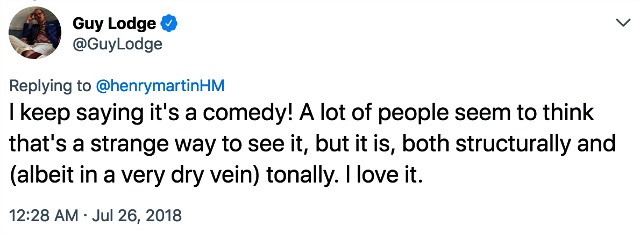Although it didn’t strike me as anything more than dryly amusing in a spotty, in-and-out sense (i.e., occasionally smirky but mostly doleful), I agreed after the fact that Phantom Thread could be processed as a kind of dry, cold comedy. I knew the hipper-than-thous were saying this in their salons and so I figured “sure, okay…I’ll bend over backwards and meet the Guy Lodge cabal halfway.”
But an “after the fact” accommodation invalidates any notion of actual comedy being the intent. It was received that way by smarty-pants types, but this is why people don’t trust critics as a rule. Because they tend to enjoy perverse, understated, “are you hip enough to get it?” humor more than any other kind, whereas Joe Popcorn tends to prefer films that are actually funny in a cards-face-up sense.
My preferred type of humor is the subtle, no-laugh-funny kind in Shampoo, Greenberg, The Informant! and Logan Lucky, the kind that no one is making a great effort to “sell” but has obviously been conceived and written with a certain humorous intent. Phantom Thread doesn’t park its car in this garage. The humor is in the performances (DDL and Manville’s) and less so the writing.

From “Paul Thomas Anderson’s Howl,” posted on 12.7.17: “I personally loved the give-and-take scenes between Reynolds and Alma and Reynolds and Cyril; all that repressed emotion behind witheringly cutting lines. The audience I saw it with laughed loud and hard at some of that stuff, as though it were a drawing-room comedy, which seemed strange. Oscar Wilde-ish Phantom Thread‘s dialogue is not; what dark humor there is lies in the acting, rather than the writing.
“It’s always fascinating to watch DDL work because he’s so good. But you feel the effort more when the material is as thin as this. In the end the film doesn’t pay off, emotionally or dramatically. But that’s never been what Anderson’s films are about. He seems to purposely avoid anything that would gratify any audience member in an obvious way.
“An audience film immediately announces what it’s about, tells a linear story with characters who are not only easy to understand and identify with but who make you eager to root for them. Audience films invite you in, show you around and make you comfortable so that you always know where you are. The Post is a good example of a well-made audience film.
“Critics’ films make you come to them. They challenge you to essentially jump aboard an already moving train and figure out where it’s going. The best critics’ films pay off that bet for audiences who believe the critic and take the challenge; the worst critics’ films (like The Master) have champions who make you believe there’s more than meets the eye here when, in fact, it’s all in their film-theory-addled imaginations.
“I believe this film falls into the latter category: It is the kind of film that makes people hate the critics whose reviews convince them to see it. This one isn’t as opaque as most of his films, but it makes you work harder than the average moviegoer wants to work. I see it sinking out of sight almost as soon as it it’s released, with perhaps critic-award nods for Lesley Manville.
“As for the Hitchcock stuff, again, it’s all misdirection toward some larger illusion that this guy has made a coherent, involving film. I was never bored. But I was also never satisfied.”
I don’t know what Phantom Thread‘s p & a buys came to, but it cost $35 million to make. It made $21 million domestically and $25 million foreign.









